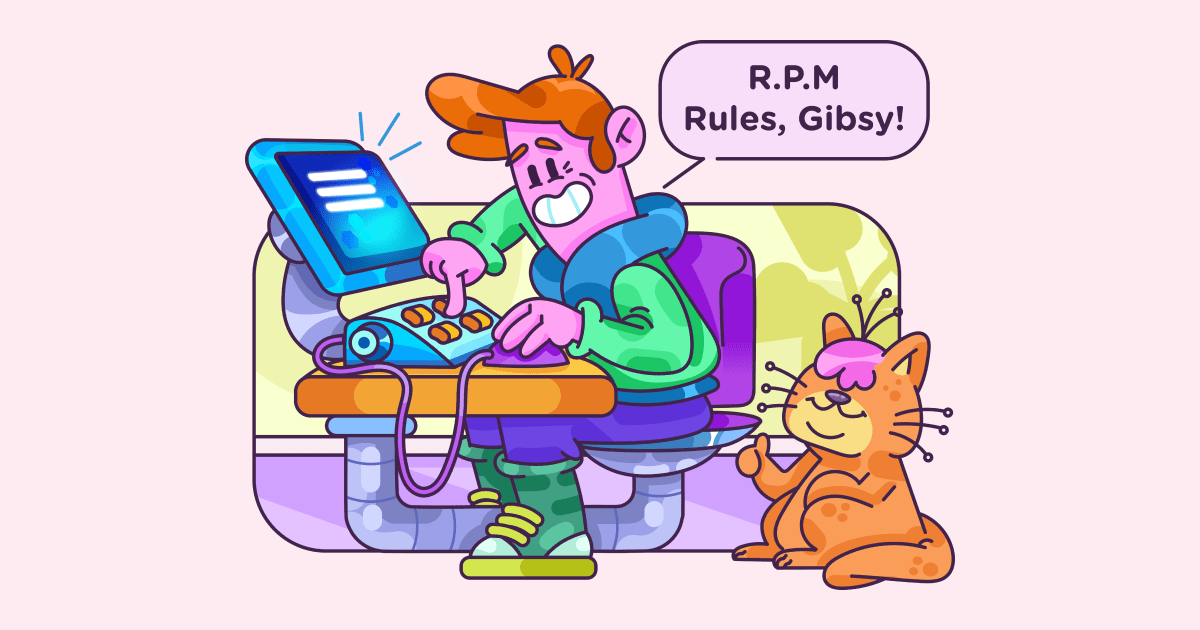Don’t Break the Chain: a productivity technique for building good habits
Last updated on: May 30, 2022
It’s believed that it takes 10,000 hours of practice to become an expert in anything. But have you ever wondered how to motivate yourself to practice for 10,000 hours?
You have to be consistent, which is not easy. However, there are some methods that can help you, such as Don’t Break the Chain. In this article, we’ll explore what the Don’t Break the Chain method is, how to make the most of it, and what’s the best way to form a positive habit.

Table of Contents
What is the Don’t Break the Chain technique?
Don’t Break the Chain or The Seinfeld Method is a productivity technique attributed to Jerry Seinfeld (even though he claims it’s not his idea).
Allegedly, Brad Isaac, an aspiring comedian at the time, found himself in the same comedy club as Jerry Seinfeld. Naturally, he asked Seinfeld for advice. In the Lifehacker article, Isaac described that encounter:
“He said the way to be a better comic was to create better jokes and the way to create better jokes was to write every day. He told me to get a big wall calendar that has a whole year on one page and hang it on a prominent wall. The next step was to get a big red magic marker. He said for each day that I do my task of writing, I get to put a big red X over that day.
After a few days, you’ll have a chain. Just keep at it and the chain will grow longer every day. You’ll like seeing that chain, especially when you get a few weeks under your belt. Your only job is to not break the chain.”
That’s the story — no matter if it’s true or not, the described productivity technique can help you reach your goals and grow as an individual.
Now, how do you know this technique is for you? Well, you might want to implement it in the following cases:
- You want to build long-term habits,
- You like crossing things off a list,
- You want a super simple productivity technique,
- You like having a visible representation of your progress.
Four easy steps of the Don’t Break the Chain technique
To implement the Don’t Break the Chain technique, you’ll need to follow four steps:
- Set a goal to adopt a good habit. It can be working out, eating less sugar, meditation, learning a language, playing an instrument, writing, painting, or any other thing you’d like to get better at.
- Make sure your goal is specific and realistic. Don’t set a goal that will overwhelm you; if you want your habit to last, it has to be sustainable. Pick something that makes a difference, but can be done even when you’re busy or don’t feel like it — for example, drawing one sketch or reading 10 pages of a book. If you’re feeling motivated, you can always do more, but don’t choose something that will be hard to keep up with when you’re not eager and inspired.
- Grab a calendar and mark a big, red X for each day you meet your goal. Focus on accomplishing your task one day at a time.
- Don’t break the chain. The longer the chain, the guiltier you’ll feel if you break it.
The psychology behind habits and the Don’t Break the Chain technique
The Don’t Break the Chain technique is successful because it makes you focus on the process, not the results themselves — it helps you form a long-lasting habit. The Personality and Social Psychology Bulletin published a study that revealed that focusing on the process has a bigger effect on achieving your goals than focusing on the outcome.
In the research, students who visualized themselves preparing for a test performed better than students who visualized themselves getting a good grade. Those who visualized the process were more likely to study, which landed them better results. So, if you want to accomplish something, concentrate on the habits that will bring you results, rather than the results themselves.
Understanding the habit loop
When you’re building a new habit, it’s a good idea to be aware of the psychology of habits. A good habit you’re trying to form is usually a replacement for a bad habit you have to break. As Charles Duhigg said in his book “The Power of Habit”:
“The Habit Loop is a neurological loop that governs any habit. The habit loop consists of three elements: a cue, a routine, and a reward. Understanding these elements can help in understanding how to change bad habits or form better ones.”
The cue is something that triggers the habit. The routine is a habit you wish to change or reinforce. The reward is positive reinforcement for desired behavior.
If you want to break the loop of a bad habit you have (and at the same time, build a new, good one), here’s what you have to do:
- Define the cues that trigger your bad habit. It can be a location, a time of day, a person, an emotional state, or an immediately preceding action. Every time you catch yourself repeating a habit, try figuring out what’s the cue and determine the pattern.
- Figure out what reward(s) your bad habit gives you. For example, if you’re endlessly scrolling through social media, that may be entertainment, distraction, or connectedness.
- Think about what good habits can give you the same reward(s). If you want to feel connected, spend quality time with a friend. If you want to entertain and distract yourself, you can read a book or listen to a podcast on a topic that interests you.
How long does it take to form a habit?
It’s often believed that it takes 21 days to build a habit. The myth stems from an observation made by plastic surgeon Maxwell Maltz. He noticed a pattern that it usually took his patients around 21 days to get used to their new face or body. In 1960, he published a book “Psycho-Cybernetics” which said:
“These, and many other commonly observed phenomena tend to show that it requires a minimum of about 21 days for an old mental image to dissolve and a new one to jell.”
The book became a big success, while his words became misinterpreted as “It takes 21 days to form a habit.”
According to a 2009 study by the European Journal of Social Psychology, it can take anywhere from 18 to 254 days to form a habit. On average, a behavior becomes automatic after 66 days. The number depends on the habit in question, too: drinking a glass of lemon water in the morning is easier (and consequently, takes less time) than going to the gym.
So, when you start with Don’t Break the Chain, you can set a goal of keeping the streak for 66 days to make sure your new habit has become a part of your lifestyle.
💡Check out how to form a habit of tracking time: How to start tracking your time.
What happens if you miss a day?
There are two types of people: those who believe that if you miss a day, you should start all over again, and those who think you should just keep going. I belong to the latter category.
An all-or-nothing attitude brings more harm than good. Perfection is unattainable and the inability to do everything impeccably often causes self-guilt. Numerous studies highlight the negative effects of perfectionism, such as increased stress, analysis paralysis, and poor self-image. It also sabotages your productivity and personal growth.
As long as it doesn’t happen often, one skipped day won’t ruin your progress. However, if you think a broken chain will make you go off track, it’s better to start over again. You get to decide, you make your own rules.
It’s important to note that some types of activities require days off. Those days shouldn’t be considered as breaking the chain as long as they’re pre-planned. For instance, if you’re working out, you need rest days to let your muscles recover and reduce the risk of injuries.
Another “justified absence” is if you’re sick — in that case, you can put S on the calendar, so there is no blank space. Similarly, you can put V for when you’re on a vacation.
How to get back on track after breaking the chain?
If you struggle to continue with your habit after breaking the chain, here’s what you can do:
- Schedule a time slot for meeting your goal. Set a reminder if you have to.
- Find an accountability buddy.
- Maintain a routine and stick to your schedule.
- Prepare for success. If your goal is to eat less sugar, don’t keep sugary drinks and foods in the house. If you want to work out in the morning, lay out your gym clothes and prepare everything you need before you go to bed.
- Remind yourself of why you started.
- Take a step back and think about why you fell off track. How can you prevent it in the future?
- Don’t be too hard on yourself — fall-offs happen to everyone.
Tips for making the most out of the Don’t Break the Chain technique
If you want to excel in building good habits while using the Don’t Break the Chain technique, keep these tips in mind.
Pick only one goal at the beginning
If you’re just starting with the Seinfeld Method, it’s best to pick only one goal to focus on. Maximum two or three, if you have extra free time. Be mindful that every new habit you introduce takes time and you can’t get more hours in a day. Juggling between your usual schedule and new activities can get overwhelming (and we don’t want any additional stress).
Put the calendar where you’ll see it
Pick a perfect place for a calendar depending on what your goal is. If you want to write 500 words every day, put it near your laptop. If you aim to take 10,000 steps a day, you can put it by your front door. If you put it somewhere you’ll see it often so that today’s blank space can annoy you, even better.
When you look at it, it should remind you of meeting your goal and not breaking the chain. After a while, your brain will start associating the location with the activity.
Determine what accomplishing a daily goal means beforehand
Before you start, precisely define what your goal is. Not doing that was my main problem when I first started — I would find every loophole and convince myself I somehow deserved to mark X on the calendar, even though I didn’t. For example, “Read more” is not specific enough; “Read 20 pages of a book every day” is better.
But, you can get into even more detail. Does it count if you read articles instead of a book? Can you mark the task as completed if you read 18 pages, or does it have to be strictly 20? If you decide to switch to an audiobook, how many minutes will 20 pages translate to? Decide on these finer details and mark them down, for future reference.
Set deadlines for your streak
The task of not breaking the chain for the rest of your life can be a bit much, to say the least. So, set a deadline for your streak, e.g. a 30-day streak or a 100-day streak, to make it easier to mentally handle it. When you accomplish your goal, reward yourself (see the heading below) and set a new deadline.
Motivate yourself
You can motivate yourself in two ways (it’s allowed — even preferred — to use both):
- Find your “why”. Why have you chosen that goal? When motivation inevitably wears off, you’ll have to remind yourself why you even started. And if you don’t have a satisfactory answer, it’s not very likely the habit will stick. Things don’t last long-term without a good reason.
- Set up a reward system. I’m a big advocate of treating yourself, especially when you deserve it. If you manage to not break the chain for a month, buy yourself something you want. Knowing you’ll get a reward if you accomplish your goal will give you some additional motivation to succeed.
Choose a tool that works best for you
All you need for this technique is some type of calendar, everything else depends on you. According to your preferences, you can choose:
- A wall calendar,
- A desk calendar,
- A mini calendar that fits in your bag,
- Google Calendar (or any other digital calendar)
- A habit tracker app, such as Streaks or Habit List,
- A habit tracker in your planner or bullet journal.
Conclusion
Doing something good for you every day takes dedication, discipline, and good organization. Breaking bad habits is hard, especially at the beginning. The good news is that it gets easier over time: after a while, you’ll be able to do it without even thinking about it. Until that happens, just focus on the process and, of course, don’t break the chain.
✉️ What habit(s) do you want to build? Have you already tried the Don’t Break the Chain technique? Let us know at blogfeedback@clockify.me for a chance to be featured in this or future posts.





